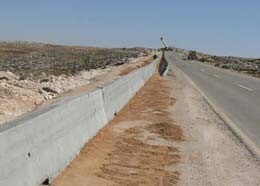B'Tselem 27 December 2006

The concrete barricade. (Photo: The Association for Civil Rights in Israel, Feb. 2006)
The structure increased the isolation of some 4,000 Palestinians living in eighteen villages southeast of Route 317. Yatta, the town on which these residents are completely dependent for services and consumer goods, is located on the other side of the barricade. Also, the barricade restricted the access of many farmers from Yatta and nearby villages to their farmland, which lies southeast of the barrier.
The High Court ruled that the barricade “harms the livelihood of residents of these villages, who have to go the town centers in the area to market their products, and it substantially increases the costs of vital commodities, such as water, food, fuel, and food for livestock. As a result, the concrete barricade infringes the right to property, freedom of movement, and the right to education, health, family life, and dignity.”
Since the beginning of the occupation, every government of Israel has viewed the southern Hebron hills as an area that Israel would ultimately annex. Israel has established seven settlements in the area, in which 3,200 residents now reside, and the government is continuously expanding them. Since 1999, Israel has worked to expel residents from the Palestinian villages southeast of Route 317, claiming urgent military necessity.
Originally, Israel planned the separation barrier’s route to run north of the Israeli settlements in the area, which would result in their de facto annexation. However, following the High Court’s decision in Beit Sourik, the state had to change the route and run it closer to the Green Line. The decision to build the barricade along Route 317 rendered the change in route meaningless and returned the original route “through the back door.” By doing this, the government sought to benefit from both worlds: on the one hand, continue its plans for developing the settlements and annexation, and on the other hand, be seen to take into account Palestinian needs by altering the separation barrier’s route and running it along the Green Line.
In its decision, the High Court stated that, “the concrete barricade does not meet the second sub-test of proportionality. When the respondents are presented a few rational alternatives to achieve the same security objective, they must select the one that harms human rights the least. The respondents did not meet this obligation.”
The High Court did however permit the construction of an alternative barrier that would enable pedestrians as well as sheep and goats to cross.
Related Links